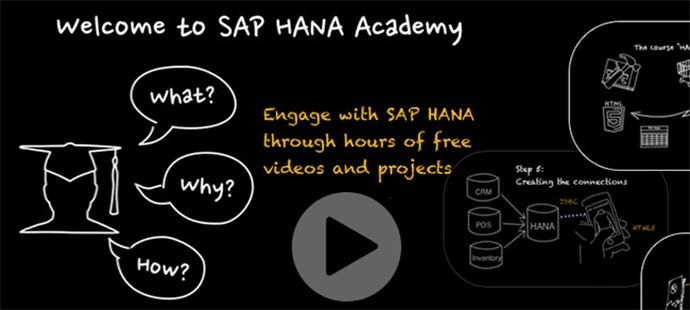
At SAP TechEd in Amsterdam, I caught up with Philip Mugglestone to chat about his work teaching SAP HANA at the SAP HANA Academy.
Philip, what’s your role and background?
 I’m a senior director of the SAP HANA Academy. I mainly have an analytics background: more than 10 years with SAS and many years with Business Objects. I’m passionate about predictive and data mining, UI development, and analytics in general.
I’m a senior director of the SAP HANA Academy. I mainly have an analytics background: more than 10 years with SAS and many years with Business Objects. I’m passionate about predictive and data mining, UI development, and analytics in general.
What is the HANA Academy?
The HANA Academy provides you with “how to” tutorial videos, which allow you as a developer to actually see how you do things with HANA. It’s not to sell you HANA, it’s to show you how to actually how to use it, answering questions like “what’s the syntax”, “where do I click”, etc.
The Academy is now a year old, with 350+ video tutorials, 100,000 visitors, and over 1000,000 page views. The tutorials cover all aspects of HANA: how to restart HANA servers, how to create a user, and so on. For example, there’s a video on how to use each of the predictive algorithms available in SAP HANA. The site was inspired by the Khan academy, with five to eight minute videos on specific topics — and it’s free, with no registration required.
The videos are made by a team of six people spread across the world: Joe King, Julie Blaufuss, Denis Van Kempen, Jamie Wiseman, Tahir Babar Hussain (known to all as “Bob”) and me. The videos are hosted on YouTube, but you can access them through the academy web site: http://academy.saphana.com.
We also provide all the code next to the video, and you can request a developer sandbox so that you can follow along with the training. The videos are all in English, but we have a team in China working on creating voiceovers.
We also provide end-to-end scenarios, to help you through the process of building a whole enterprise solution. For example, we have one called “HANA recommends” – it’s a retail-focused, business-to-consumer customer loyalty application that makes real-time recommendations.
The tutorials don’t only include HANA, but also cover the SAP UI5, web services, the mobile application, etc. A version is available on the Apple appstore: HANA Recommends example application.
Screen shots from the “HANA Recommends” application that you can build by following the videos on the HANA Academy web site.
What are things have you been working on?
Not only do we have all this content online, but we also go and teach it in free, three-day boot camps around the world. So far we’ve done this in Palo Alto, Sydney, Shanghai, and Bangkok, mainly with partners, and the feedback has been very positive. We ask attendees to bring along some real-life customer data, and by the end of the three days, they leave with a working application, giving real-life recommendations. We now have customers that are getting close to going production with applications that were built in the workshops.
The workshops have been so successful that we are now expanding it to focus on a broader set of industry solutions, starting with a three-day session in Paris before the end of this year. It’s open to development partners, consulting organizations, and developers among our customers. If you’re interested, there are still places left… to sign up, send an email to hanaacademy@sap.com.
How do you handle updates to the materials?
That’s a great question, because everything changes fast as HANA adds new features. We try to make sure everything’s up to date, but we also want to provide content for people who aren’t on the latest versions. In general, we don’t re-record if there’s a just a small change to the user interface, but if the change means the tutorial no longer works, we’ll redo it. For HANA service pack 6 we had twenty new videos available on day 1, and we’re looking to do something similar for Service Pack 7 later this year.
How does this relate to other HANA learning and development outreach programs such as the OpenSAP courses?
Everything’s complementary. You can do the HANA course on the openSAP site, but still want to be reminded about how to use a specific feature. Or vice-versa, you can look at some videos, then decide to do a full certification course, with exams, tests, etc. – which we don’t offer on the Academy site. And of course there’s lots of other material for developers available on the SAP Community site and other channels.
What are the plans for the future?
We’re continuing to broaden the scope of the Academy next year, with more bootcamps around the world on a bi-monthly basis, and more videos. There’s a huge list of new things to cover, such as text analysis, the new features coming up in SP7, the changes in predictive that are coming because of the KXEN acquisition and the partnership with SAS.
The biggest challenge we face is knowing what to do first – and so we’d also like to expand the community aspect to the site, so that we can get more feedback on prioritization, and maybe even some help on producing materials – we’re not a large team, and HANA is evolving constantly. We can provide video production, if anybody inside or outside of SAP is interested in helping.
We’re also going to add learning maps. Right now, we have sections by topic, but we don’t have something that says “if you’re new to HANA, we recommend you take courses A, B, and C”.
Finally, we’re also looking at other streaming/video delivery options, because YouTube is not available in China, for example.
Follow @saphanaacademy on twitter for more news!





